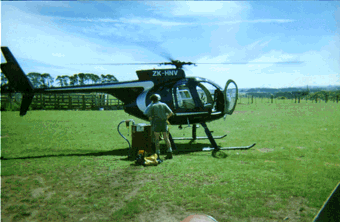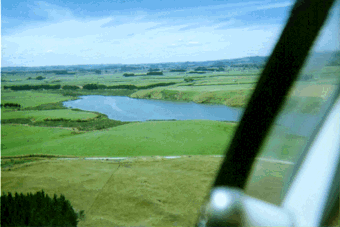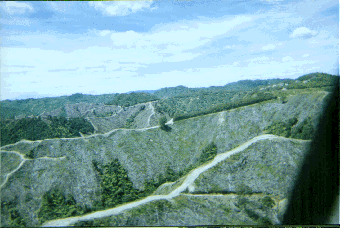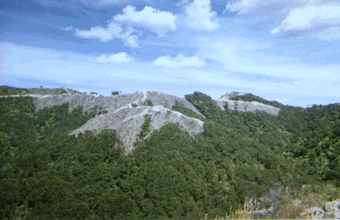Press any of the buttons below to go to my other pages.
You are currently on a
![]()
page.
Disclaimer: these pages reflect my own personal opinions and do not necessarily reflect Department of Conservation policy or opinions

Dreams and nightmares.
December 9, 1998 I wrote "I was hoping to tell you about my second ever helicopter trip and more about the Ruahines, but another bout of Glandular fever put me in bed for a week, so I missed out. Sometime soon hopefully".
Well, my second every helicopter trip happened sooner than I expected, today, the 3rd of February, in fact. It was great, three and a half-hour of flying low over the ground in a Hughes 500. I certainly hadn't anticipated flying around for that long.

JC and NM have been giving me heaps, teasing me that I was likely to get airsick sitting in the back of the helicopter, "remember to bring a sickbag". Or die from the exhaust fumes not venting properly. Or that there wouldn't be a seat in the back for me, and I that I would have to bring along one of the office chairs. "Make it one of the ones with castors on the feet, so you will go shooting out the open door when we do a steep turn." I must admit that they were starting to get me a bit worried. Not about getting airsick. Sailing in storms has proven to me that I have an unmovable stomach, but I wasn't to sure about the rest of it.
Anyway, I severely disappointed both of them. I loved flying!! Even more than I thought I would, and scooting low over the ground just made it all the more exciting. No airsickness, exhaust fumes or coaster seats for me. PR the pilot is a real honey, and certainly didn't mind putting the backseat in for me. JC and NM reckon that he was being nice to me and flying quite gently. I think that they are just disappointed that I didn't throw up.

Of course, we weren't up there just for fun, we were on a serious mission. There is a new weed on the rampage, Hemp Agrimony (Eupatorium cannabinum) which is particularly partial to swamp edges and semi-swamp areas. I don't know what it is about weeds but a lot of them take about 50 years to become weeds. Not sure if that is because it takes that long to build up a sufficiently dense population to get noticed, or if it is that it takes that long for the plant to adjust to the country and become rampant.
Hemp Agrimony is quite attractive with its pink flowering heads. It was probably introduced into the country as a garden ornamental. Shame it didn't stick to gardens, but has ventured outside. It belongs to the daisy family, and has fine wind distributed seed (Oh bummer).
 Within the Wanganui conservancy, we have a very important and large
dune wetland system called Ihupuku swamp. This swamp consists mostly
of numerous interconnecting shallow arms with the occasional larger
water body. The only reason it is still here, and not drained as so
many other swamps around the country, is that the iron sand works,
that used to be near the beach, needed large quantities of water to
wash the sand and for other industrial process. The swamp area was
the water reservoir. The iron works are long since defunct, but
luckily, the swamp is still there.
Within the Wanganui conservancy, we have a very important and large
dune wetland system called Ihupuku swamp. This swamp consists mostly
of numerous interconnecting shallow arms with the occasional larger
water body. The only reason it is still here, and not drained as so
many other swamps around the country, is that the iron sand works,
that used to be near the beach, needed large quantities of water to
wash the sand and for other industrial process. The swamp area was
the water reservoir. The iron works are long since defunct, but
luckily, the swamp is still there.
Unfortunately, so is hemp agrimony now. We flew the entire swamp with the helicopter to spot just how far the agrimony had penetrated. Several arms have a dense understory of agrimony, other areas just the occasional plant, and large areas nothing yet. We were hoping that it might be a local infestation that could still be controlled by a major helicopter weed spray programme, even though this would affect the composition of the swamp in the short term. However, we now know that the weed has probably already traveled more than 20 kilometers. It is found from about Hawera downwind to Ihupuku swamp. Yet another weed that is too far gone to eradicate completely, add another nightmare to the weed control list.
The other nightmare was a forest clearing project on the border of Wanganui and Taranaki District councils. This is only a nightmare for people like me who hate any native forest chopped down. For the farmer it is a potentially business saving proposition and for the forest company just another forest operation. The area is very marginal for farming, so marginal in fact that the bush has been allowed to grow back.
 The 30-year-old manuka forest is being roller crushed to plant up
in pines. Roller crushing uses a big heavy drum, with spikes on it,
which is lowered and raised by winch from a bulldozer. It is heavy
enough to knock over and crush small and medium sized trees.
Of course, you have to bulldoze tracks along the ridges to get the
dozer in.
The 30-year-old manuka forest is being roller crushed to plant up
in pines. Roller crushing uses a big heavy drum, with spikes on it,
which is lowered and raised by winch from a bulldozer. It is heavy
enough to knock over and crush small and medium sized trees.
Of course, you have to bulldoze tracks along the ridges to get the
dozer in.
My concerns are that the area is known for kiwis and manuka scrub makes good kiwi habitat. Many other bird species (and probably lizards etc)live in that area too. The clearance of the forest and bulldozing of the ridges encourages soil slippage, especially because the whole area is very steep anyway. Surrounding areas, which already have been planted up in pine, are still slipping even after 5 years. This pollutes the waterways, kills fish and destroys other stream and marine life.
I also wonder about the whole viability of the scheme. New Zealand forest is rather like tropical forest, most of the nutrients are stored in the trees and plants, not in the shallow layer of topsoil. So, you lose a lot of nutrients by removing the trees. The thin topsoil washes easily off the papa-mudstone. What soil is left will not support more than two rotations of pine and the growth rates tend to be poor in any case. So why even bother with the huge expense? Especially when there are plenty of fully developed farms around that are up for sale. They would take a lot less time, money and effort to plant up and no forest is destroyed in the mean time

Part of the problem lies in the legislation by different district and regional councils. In Taranaki District, clearing of forest is a permitted activity under the District plan and Resource Management Act. In Wanganui District, it requires consent. This farm straddles the boundary, and roller-crushing was stopped on the Wanganui side, but continues blithely on the Taranaki side. The Resource Management Act is supposed to be a world-leading piece of legislation that requires everybody to consider the environmental impacts of any activities. Unfortunately, it is up to District and Regional Councils to interpret it for their areas, and different interpretations abound.
I'm not sure how to this situation should be dealt with. On the one hand, the land should never have been cleared for farming in the first place, and it doesn't seem particularly useful to clear it again. Many farmers walked off the land in the 1930's, that is why the land has reverted to forest again. Allowing the reversion to forest is still the best option for the land. However, I can also see the point of view of the farmer, trying to eke a living out of unviable land, and not wanting to give up or go broke.
This sort of forest clearing, and this is just one example, it happens quite a lot, does not tally with New Zealand's supposedly "Clean, green" image. It seems rather ironic in the face of our protests over clearing forest in the Amazons and other tropical areas. Worst of all, nobody seems to be considering the displaced or roller-crushed animals and plants. We don't know exactly which species lived in the area, and now we never will.